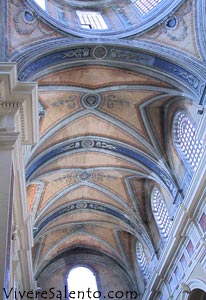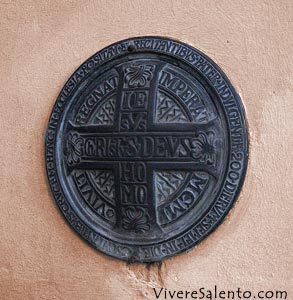|
|

| Inhabitants'name: Taurisanesi |
The civic coat of arms of Taurisano is
characterized by a bull whose tail is pointed towards the head as if it is
 going
to run towards an enemy. This animal recalls the hypothesis that in the Roman
period the town was a breeder bull farm. The village could also be named after
the Roman centurion Taurisianus who was given the town for his victories in the
war. The territory of Taurisano is rich in archaeological finds such as
megalithic objects and monuments even if the first historic documents date to
the 12th century. From this document we learn that Tancredi D’Altavilla left the
feud to Filiberto Monteroni who became the first feudatory in 1191. At the
beginnings of the 13th century the Swabian Federico II took the place of the
Normans. He gave the Princedom of Taranto (including Taurisano) to his son
Manfredi. He was in bad relations with the Pope Innocence IV, and , when his
father died, the Pope joined Carlo D’Angiò in the conquest of South Italy.
Manfredi was defeated and the village was given to the Baron Hugo de Taurisano.
His sister Adelasia, reigned after him, she sold the village to the Monteronis
in 1444, whose last heir, Francesco, died in 1536. The village became again a
property of the king Carlo V who gave it to the Gattinaras. Antonio Gattinara
sold everything he had to Giovan Battista Saraceno, baron of Andrano with the
clause to be able to repurchase it. In 1550 he died and his son Mercurio bought
the village which passed to the Ruizes De Castro in 1578 and in going
to run towards an enemy. This animal recalls the hypothesis that in the Roman
period the town was a breeder bull farm. The village could also be named after
the Roman centurion Taurisianus who was given the town for his victories in the
war. The territory of Taurisano is rich in archaeological finds such as
megalithic objects and monuments even if the first historic documents date to
the 12th century. From this document we learn that Tancredi D’Altavilla left the
feud to Filiberto Monteroni who became the first feudatory in 1191. At the
beginnings of the 13th century the Swabian Federico II took the place of the
Normans. He gave the Princedom of Taranto (including Taurisano) to his son
Manfredi. He was in bad relations with the Pope Innocence IV, and , when his
father died, the Pope joined Carlo D’Angiò in the conquest of South Italy.
Manfredi was defeated and the village was given to the Baron Hugo de Taurisano.
His sister Adelasia, reigned after him, she sold the village to the Monteronis
in 1444, whose last heir, Francesco, died in 1536. The village became again a
property of the king Carlo V who gave it to the Gattinaras. Antonio Gattinara
sold everything he had to Giovan Battista Saraceno, baron of Andrano with the
clause to be able to repurchase it. In 1550 he died and his son Mercurio bought
the village which passed to the Ruizes De Castro in 1578 and in 1663 was sold to Bartolomeo Lopez y Royo. This was the last family to rule the
village because in 1806 the feudal system was suppressed. Among the famous
people born in Taurisano we can remember: Giulio Cesare Vanini was born in 1875
in a wealthy family. He left the village when he was 16 and he never came back.
When his father died, he was in great financial difficulties and entered the
Carmelite Convent in Naples. In 1605 he took vows. He took his degree in law and
studied also Philosophy and Theology. He moved to Paris where he published two
works of atheistic subject and, in order to avoid troubles, he moved to Tolosa.
In 1619 he was accused of being an atheist and a swearer and was sentenced to
death. Before the execution they imposed him to repent and to ask God for
forgiveness but he refused since he was atheist, and his tongue was torn off and
he was burnt alive. Among the other illustrious people we remember: Alessandro
Lopez y Royo, Giuseppe Baglivo, Ugo Orlando and Aldo Sabato.
1663 was sold to Bartolomeo Lopez y Royo. This was the last family to rule the
village because in 1806 the feudal system was suppressed. Among the famous
people born in Taurisano we can remember: Giulio Cesare Vanini was born in 1875
in a wealthy family. He left the village when he was 16 and he never came back.
When his father died, he was in great financial difficulties and entered the
Carmelite Convent in Naples. In 1605 he took vows. He took his degree in law and
studied also Philosophy and Theology. He moved to Paris where he published two
works of atheistic subject and, in order to avoid troubles, he moved to Tolosa.
In 1619 he was accused of being an atheist and a swearer and was sentenced to
death. Before the execution they imposed him to repent and to ask God for
forgiveness but he refused since he was atheist, and his tongue was torn off and
he was burnt alive. Among the other illustrious people we remember: Alessandro
Lopez y Royo, Giuseppe Baglivo, Ugo Orlando and Aldo Sabato.
|